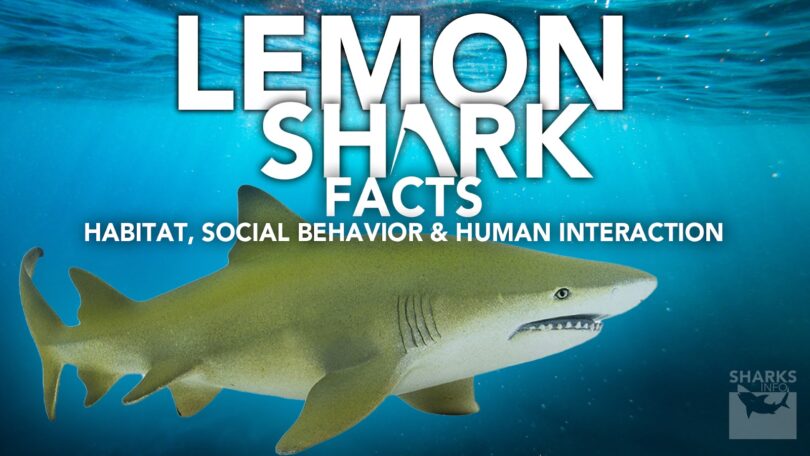Lemon sharks are notable species of shark due to their color; they are found residing in the shallow waters of the ocean. There are multiple fascinating facts about them that make people more interested in these species. Let’s know more about these species.
Lemon Shark – Species Profile
Scientific name: Negaprion brevirostrus
Taxonomic Classification
| Kingdom | Animalia |
| Phylum | Chordata |
| Class | Chondrichthyes |
| Order | Carcharhiniformes |
| Family | Carcharhinidae |
| Genus | Negaporian |
| Species | brevirostrus |
Physical Appearance
Lemon sharks have a yellow-brown coloration that gives them their name, and they have a distinctive flattened snout and large eyes. They have a cylindrical body shape with a relatively small first dorsal fin and a large second dorsal fin. The caudal fin is large and has a unique crescent-like shape, and the pectoral fins are wide and triangular. They have small, sharp teeth arranged in multiple rows. Lemon sharks typically grow to be about 10-14 ft in length and can weigh up to 500 lbs.

Habitat / Geographical distribution
Found in the Atlantic and Southeast Pacific Oceans, the lemon shark is distributed from the coastal areas of Virginia to Brazil.
Lemon sharks inhabit the shallow tropical and subtropical waters, right around the coral reefs and mangroves. Though they move to the depths of the ocean, usually they enjoy their time in the shallow waters due to the abundance of their favorite food.

Diet
Lemon sharks have a versatile diet in which they like to feed on crustaceans, bony fish, small sharks, rays, and mollusks, and sometimes do try to catch the seabirds.
Hunting Strategy
With the help of their strong senses, lemon sharks detect their potential prey’s electric signals and wait for the right moment to attack. As soon as they capture their prey, they thrash their heads to tear the flesh and then consume it as a whole.

Reproduction
Instead of laying eggs, lemon sharks give birth to the young ones as they are viviparous. Female lemon sharks follow a gestation period of 10-12 months, during which, the pup gets nourished via the placental connection. One litter of lemon sharks is usually of 17 pups. When these pups are born, they prefer to reside in the shallow waters for a time and later move to the deeper waters. These pups become sexually mature at the age of 12-16 years.
Conservation Status
The lemon shark is considered to be Vulnerable to extinction, as per IUCN. Human activities like fishing, incidental bycatching, and oceanic pollution are some of the major causes behind the decrease in their number.
Social Behavior
Lemon sharks are social animals and often form groups or schools. They are not aggressive towards each other and engage in peaceful interactions such as mutual grooming and touching. However, they are also territorial and may defend their feeding or mating grounds from other lemon sharks. During mating season, male lemon sharks may become more aggressive and compete for mating opportunities with females. Overall, lemon sharks exhibit a complex social structure, which is influenced by various environmental and ecological factors.

Human Interaction
Most human interactions with lemon sharks are peaceful and based on observation. Lemon sharks are often observed while they feed, mate, or swim. They are curious animals and often approach divers and snorkelers. This can be an exciting experience, but it is important to remember not to invade their space and not touch or chase them.
In some areas, lemon sharks are hunted for their fins and meat, which can be detrimental to their populations. Additionally, the loss of their natural habitat and the pollution of their environment can also impact the survival of lemon sharks.
Interesting Facts About Lemon Sharks
They are one of the most interesting species of shark found in the ocean. Here are 10 interesting facts about lemon sharks:
1: Named for their yellow color: Lemon sharks get their name from their bright yellow color, which helps them blend into the sun-drenched waters of their habitat.
2: Found in shallow waters: Lemon sharks are typically found roaming in the costa areas’ shallow waters and in estuaries, which makes them relatively easy to observe.
3: Carnivorous: Lemon sharks are carnivores, feeding mainly on fish, crustaceans, and squid.
4: Migration: Lemon sharks migrate long distances, from their birth and nursery grounds to their mating and pupping areas.
5: Social behavior: Lemon sharks are social animals, often forming schools and exhibiting cooperative behavior.
6: Live long lives: Lemon sharks can live up to 20 years in the wild, making them one of the shark species that are long-lived.
7: Excellent swimmers: Lemon sharks are excellent swimmers, able to swim quickly and easily through the water.
8: Good vision: Lemon sharks have excellent vision, which helps them find prey and avoid danger.
9: Reproduction: Lemon sharks give birth to live young, usually two to four pups at a time, and have a long gestation period of around 12 months.
10: Threats: Lemon sharks are not considered endangered, but are threatened by overfishing and habitat destruction, as well as being caught as bycatch in fishing gear.
The Bottom Line
Lemon sharks have a yellow-brown coloration that gives them their name, and they have a distinctive flattened snout and large eyes. They are fascinating creatures of the ocean that are known to play a vital role in balancing the ocean’s ecosystem.







